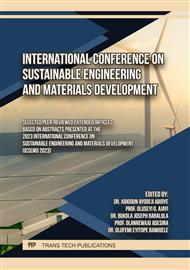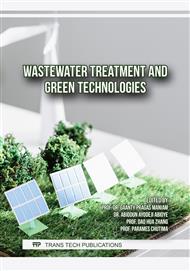[1]
G. M. Abdullah, & A. Abd El Aal. (2021). Assessment of the reuse of Covid-19 healthy personal protective materials in enhancing geotechnical properties of Najran's soil for road construction: Numerical and experimental study. Journal of Cleaner Production, 320, 128772.
DOI: 10.1016/j.jclepro.2021.128772
Google Scholar
[2]
M. Yadav, & S. Sinha. (2022). Waste to wealth: Overview of waste and recycled materials in construction industry. Materials Today: Proceedings.
DOI: 10.1016/j.matpr.2022.06.245
Google Scholar
[3]
H. K. Hamzah, G. F. Huseien, M. A. Asaad, D. P. Georgescu, S. K. Ghoshal, & F. Alrshoudi. (2021). Effect of waste glass bottles-derived nanopowder as slag replacement on mortars with alkali activation: Durability characteristics. Case Studies in Construction Materials, 15, e00775.
DOI: 10.1016/j.cscm.2021.e00775
Google Scholar
[4]
G. Lazorenko, A. Kasprzhitskii, & E. H. Fini. (2022). Sustainable construction via novel geopolymer composites incorporating waste plastic of different sizes and shapes. Construction and Building Materials, 324, 126697.
DOI: 10.1016/j.conbuildmat.2022.126697
Google Scholar
[5]
K. Gilbert, S. Jutras, & A. P. Plamondon. (2021). Suspended sediment input from crushed-stone ford construction on the Canadian Shield in Quebec. Environmental Challenges, 5, 100388.
DOI: 10.1016/j.envc.2021.100388
Google Scholar
[6]
J. Zhu, X. Chen, J. Ruan, Y. Li, E. He, & Z. Xu. (2019). A safe and efficient technology of recovering nano glass from penicillin bottles of medical wastes. Journal of cleaner production, 229, 632-639.
DOI: 10.1016/j.jclepro.2019.05.072
Google Scholar
[7]
M. Oyinlola, T. Whitehead, A. Abuzeinab, A. Adefila, Y. Akinola, F. Anafi, & E. Mosugu, E. (2018). Bottle house: A case study of transdisciplinary research for tackling global challenges. Habitat International, 79, 18-29.
DOI: 10.1016/j.habitatint.2018.07.007
Google Scholar
[8]
W. Ferdous, A. Manalo, R. Siddique, P. Mendis, Y. Zhuge, H. S. Wong, & P. Schubel. (2021). Recycling of landfill wastes (tyres, plastics and glass) in construction–A review on global waste generation, performance, application and future opportunities. Resources, Conservation and Recycling, 173, 105745.
DOI: 10.1016/j.resconrec.2021.105745
Google Scholar
[9]
T. Ali-Boucetta, M. Behim, F. Cassagnabere, M. Mouret, A. Ayat, & W. Laifa. (2021). Durability of self-compacting concrete containing waste bottle glass and granulated slag. Construction and Building Materials, 270, 121133.
DOI: 10.1016/j.conbuildmat.2020.121133
Google Scholar
[10]
F. I. Karatas-Aydin, & M. Isiksal-Bostan. (2023). Engineering-based modelling experiences of elementary gifted students: An example of bridge construction. Thinking Skills and Creativity, 47, 101237.
DOI: 10.1016/j.tsc.2023.101237
Google Scholar
[11]
Q. Tushar, S. Salehi, J. Santos, G. Zhang, M. A. Bhuiyan, M. Arashpour, & F. Giustozzi. (2023). Application of recycled crushed glass in road pavements and pipeline bedding: An integrated environmental evaluation using LCA. Science of The Total Environment, 163488.
DOI: 10.1016/j.scitotenv.2023.163488
Google Scholar
[12]
D. Robert, E. Baez, & S. Setunge. (2021). A new technology of transforming recycled glass waste to construction components. Construction and Building Materials, 313, 125539.
DOI: 10.1016/j.conbuildmat.2021.125539
Google Scholar
[13]
G. Bilgen, & O. F. Altuntas. (2023). Sustainable re-use of waste glass, cement and lime treated dredged material as pavement material. Case Studies in Construction Materials, 18, e01815.
DOI: 10.1016/j.cscm.2022.e01815
Google Scholar
[14]
A. Gedik. (2021). An exploration into the utilization of recycled waste glass as a surrogate powder to crushed stone dust in asphalt pavement construction. Construction and Building Materials, 300, 123980.
DOI: 10.1016/j.conbuildmat.2021.123980
Google Scholar
[15]
Y. Li, J. Zhang, Y. Cao, Q. Hu, & X. Guo. (2021). Design and evaluation of light-transmitting concrete (LTC) using waste tempered glass: A novel concrete for future photovoltaic road. Construction and Building Materials, 280, 122551.
DOI: 10.1016/j.conbuildmat.2021.122551
Google Scholar
[16]
E. El-Seidy, M. Chougan, M. Sambucci, M. J. Al-Kheetan, M. Valente, & S. H. Ghaffar. (2023). Lightweight alkali-activated materials and ordinary Portland cement composites using recycled polyvinyl chloride and waste glass aggregates to fully replace natural sand. Construction and Building Materials, 368, 130399.
DOI: 10.1016/j.conbuildmat.2023.130399
Google Scholar
[17]
M. M. Meraz, N. J. Mim, M. T. Mehedi, E. N Farsangi, R. K. Shrestha, S. A. K.. Arafin, & M. M. Meraz. (2023). Performance evaluation of high-performance self-compacting concrete with waste glass aggregate and metakaolin. Journal of Building Engineering, 67, 105976.
DOI: 10.1016/j.jobe.2023.105976
Google Scholar
[18]
M. Garg, & N. Verma. (2023). Experimental investigation of concrete incorporated with waste aggregates with coating of epoxy and glass fibre as replacement of coarse aggregates. Materials Today: Proceedings.
DOI: 10.1016/j.matpr.2023.03.239
Google Scholar
[19]
T. K. Mohammed, & S. M. Hama. (2023, June). Effect of combination of waste glass powder and plastic aggregate on structural behavior of reinforced concrete beams. In Structures (Vol. 52, pp.83-103). Elsevier.
DOI: 10.1016/j.istruc.2023.03.160
Google Scholar
[20]
L. Zhang, K. M. Hung, S. P. Yap, & T. H. Tan. (2023). Recycled waste glass as fine aggregate in eco-friendly gypsum-cement composite. Materials Today: Proceedings.
DOI: 10.1016/j.matpr.2023.03.470
Google Scholar
[21]
N. Sharma, P. Sharma, & A. K. Parashar. (2022). Use of waste glass and demolished brick as coarse aggregate in production of sustainable concrete. Materials Today: Proceedings, 62, 4030-4035.
DOI: 10.1016/j.matpr.2022.04.602
Google Scholar
[22]
M. Cheng, M. Chen, S. Wu, T. Yang, J. Zhang, & Y. Zha. (2021). Effect of waste glass aggregate on performance of asphalt micro-surfacing. Construction and Building Materials, 307, 125133.
DOI: 10.1016/j.conbuildmat.2021.125133
Google Scholar
[23]
R. Bahadur, & A. K. Parashar. (2023). An investigation of waste glass powder with the substitution of sand on concrete mix. Materials Today: Proceedings.
DOI: 10.1016/j.matpr.2023.02.123
Google Scholar
[24]
A. Baikerikar, S. Mudalgi, & V. V. Ram. (2023). Utilization of waste glass powder and waste glass sand in the production of Eco-Friendly concrete. Construction and Building Materials, 377, 131078.
DOI: 10.1016/j.conbuildmat.2023.131078
Google Scholar
[25]
C. Li, H. Wang, C. Fu, S. Shi, Q. Liu, P. Xu,... & L. Jiang. (2023). Effect and mechanism of waste glass powder silane modification on water stability of asphalt mixture. Construction and Building Materials, 366, 130086.
DOI: 10.1016/j.conbuildmat.2022.130086
Google Scholar
[26]
D. Harinder, B. Chandu, & M. Aditya. (2022). Evaluation of different types of soil subgrade using glass powder for Low-Volume Roads (LVRs). Materials Today: Proceedings, 62, 4487-4491.
DOI: 10.1016/j.matpr.2022.04.942
Google Scholar
[27]
R. A. Blayi, A. F. H. Sherwani, H. H. Ibrahim, R. H. Faraj, & A. Daraei. (2020). Strength improvement of expansive soil by utilizing waste glass powder. Case Studies in Construction Materials, 13, e00427.
DOI: 10.1016/j.cscm.2020.e00427
Google Scholar
[28]
F. Maghool, A. Arulrajah, B. Ghorbani, & S. Horpibulsuk. (2022). Strength and permanent deformation properties of demolition wastes, glass, and plastics stabilized with foamed bitumen for pavement bases. Construction and Building Materials, 320, 126108.
DOI: 10.1016/j.conbuildmat.2021.126108
Google Scholar
[29]
J. J. Baldovino, R. L. Izzo, J. L. Rose, & M. D. Domingos. (2021). Strength, durability, and microstructure of geopolymers based on recycled-glass powder waste and dolomitic lime for soil stabilization. Construction and Building Materials, 271, 121874.
DOI: 10.1016/j.conbuildmat.2020.121874
Google Scholar



